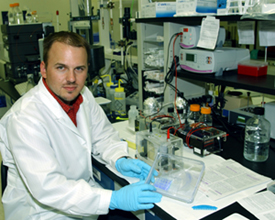Home > Introduction > Articles > Chris Burroughs > George Bachand & Smart Materials
Chris Burroughs Article on George Bachand & Smart Materials
- reprinted 08/06/2002George Bachand explores ways to develop ‘smart’ materials that behave like living systems
Sandia’s first molecular biologist seeks to design materials that have properties of living cells
By Chris Burroughs
July 26th, 2002
Imagine a new "smart" material that can "heal" itself like a living system.
It may sound like science fiction, but to Sandia molecular biologist George Bachand, such materials may be just around the research corner.
Bachand is working with Jun Liu and Bruce Bunker and a team on a project called "Active Assembly of Dynamic and Adaptable Materials." Its goal is to identify and learn how to exploit key strategies used by living systems to develop materials that can be programmed to assemble and disassemble in controlled environments.
The project is funded by the Nanoscale Science, Engineering, and Technology Initiative through the DOE Office of Basic Energy Sciences.
"With this project we are attempting to break the walls between living and nonliving systems at the nano-scale," Bachand says. "We are looking at designing materials that have properties of living cells."
Synthetic materials tend to have static structures and are not capable of adapting to a changing environment. In contrast, living systems have the ability to create, heal, reconfigure, and dismantle.
|
Sandia's diversity provides 'great' environment for biotechnology research, George Bachand says George Bachand's laboratory in Bldg. 897 looks somewhat different from other labs in the building. He has Petri dishes in refrigerators growing bacterial cells that are used in his experiments. That's not the only thing different about George at Sandia. He's a molecular virologist — someone who works with DNA/RNA of viruses. He says Sandia has provided him a "great" environment for research. The reason, he says, is that to do biotechnology well, there must be a multidisciplinary team. "The diversity of staff here has led to some fantastic ideas," he says. |

|
As part of the project, Bachand, Bunker, and Liu are studying how to mimic the dynamic assembly and active transport of living systems in new materials.
"The research moves material sciences from static structures to a regime in which materials can be assembled and reconfigured in response to an external stimuli," Bachand says.
With this understanding, a new generation of "smart," dynamic, and adaptable materials may emerge.
As a first step, the researchers plan to use or modify key components from living systems and integrate and control those components in artificial microfluidic environments.
Specifically, they will be looking at motor proteins — considered to be nature’s means for transporting cargo within living cells — as the active components in the new dynamic nanomaterials. The species Bachand is studying is kinesin, a linear motor protein that walks along fibers in a "hand-over-hand" fashion for hundreds of steps. Kinesin motor proteins are among the fastest and most efficient of motor proteins.
The motor proteins are grown in a Petri dish. Using a DNA sequence for a target protein, the specific gene that encodes the motor protein is isolated. The gene is placed into a nonpathogenic Escherichia coli strain where the motor protein is expressed and purified by liquid chromatography.
Bachand became particularly familiar with motor proteins while working as a research professor at Cornell. There, he as part of a team, used motor proteins derived from adenosine triphosphate synthase (ATPase) enzymes to power a nano-nickel propeller in a solution. The entire device, including the motor and propeller on a nickel post, was comparable in size to some virus particles.
Bachand joined Sandia last year, becoming the Labs’ first molecular biologist. Besides working on the Active Assembly of Dynamic and Adaptable Materials project, he plans to continue his efforts in using living motor proteins to power nanoelectromechanical (NEMS) systems.
"Both research efforts will give us valuable understanding of motor proteins and how they work and a means for controlling the activity of proteins in synthetic systems," Bachand says.
While Bachand has cloned kinesin motor proteins in his lab, he still needs to characterize them to better understand how they bind and move. Over the next couple of years, he will perform biochemical and biophysical analyses of the motor proteins, which should provide him insight into the structural and mechanical features of the motor protein enzymes that are critical for conversion of chemical energy into mechanical motion.
He will also genetically engineer these proteins to survive in synthetic systems, as well as provide mechanisms to control motor functions such as starting/stopping and cargo pick-up/delivery.
Bachand notes that if he and the other researchers can understand key design criteria used by living systems, they will be able to identify basic concepts that will allow them to develop artificial materials and systems that may ultimately surpass the survivability and functionality constraints of existing biological systems.
"This work holds the promise of opening up a completely new branch of material science in which the nanostructures that can be produced will only be limited by our imagination," Bachand says.
|
Team members
Principal investigators for the Active Assembly of Dynamic and Adaptable Materials are George Bachand, Jun Liu, Darryl Sasaki, Bruce Bunker, Gordon Osbourn, and Professor Viola Vogel of the University of Washington. Contributors include Alan Burns, Carolyn Matzke, Mark Stevens, Jim Martin, Henry Hess of the University of Washington, and William Woodruff of Los Alamos National Laboratory. The project coordinator is Terry Michalske. |
For more information, Contact:
Chris Burroughs
Sandia National Laboratories
(505) 822-9852
coburro@sandia.gov
Reprinted with permission. Copyright Sandia National Laboratories, Lab News and Chris Burroughs.
If you have a comment, please
us.
|
|
||
|
|
||
| The latest news from around the world, FREE | ||
|
|
||
|
|
||
| Premium Products | ||
|
|
||
|
Only the news you want to read!
Learn More |
||
|
|
||
|
Full-service, expert consulting
Learn More |
||
|
|
||